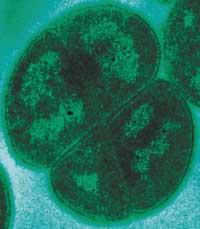Key to radiation resistance
2003/02/01 Elhuyar Zientzia Iturria: Elhuyar aldizkaria
Deinococcus radiodurans bacteria can withstand much higher doses of radiation than other living things. In fact, normally 10 grays are deadly, but neither 15,000 grays harm this bacteria. Apparently, the bacteria have an enormous capacity to repair the damage that occurs in their DNA. According to some scientists, the resistance of Deinococcus radiodurans is partly due to its morphology or appearance.

A study at the Weizmann Institute in Israel reveals that the genome of the bacteria is shaped like donuts and has four copies of the same genome, each in a compartment. To study how the genome is resolved, thousands of bacteria undergo high doses and analyze the phases of the repair mechanism. Thus they discover that in the first phase the four copies resist the form of donuts.
In the second phase, the genome expands and each copy sends its parts to the other compartments. These parts are mixed with other copies and the affected areas are repaired. In fact, it is almost impossible for all four copies to be damaged in the same places, and parts of undamaged copies can repair the damaged ones in the other compartment.

Gai honi buruzko eduki gehiago
Elhuyarrek garatutako teknologia



